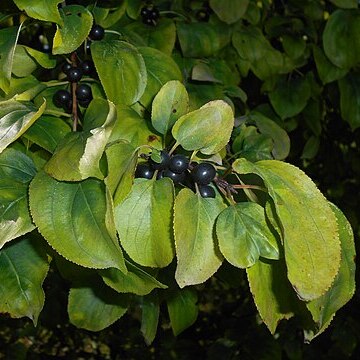Shrubs or small trees, dioecious, to 10 m tall, unarmed, much branched. Branchlets opposite to subopposite, or fascicled on short shoots, brown or red-brown, glabrous or slightly smooth, often terminating in a large bud; terminal and axillary buds ovoid, large, 5-8 mm; scales pale brown, conspicuously white ciliate. Leaves opposite or fascicled on short shoots; petiole 1.5-4 cm, glabrous or pilose; leaf blade broadly elliptic or ovate, rarely oblanceolate-elliptic, 4-13 × 2-6 cm, papery, abaxially sparsely pilose on veins, adaxially glabrous or sparsely pilose on veins, lateral veins 4 or 5(or 6) pairs, prominent on both surfaces, base cuneate or subrounded, sometimes slightly oblique, margin finely crenate, with glandular teeth, apex acute or shortly acuminate to acuminate, rarely obtuse or rounded. Flowers yellowish green, unisexual, 4-merous. Sepals very thin, translucent, 3-veined. Petals present. Male flowers 7-8 mm, very narrow; calyx tube narrowly funnel-shaped, ovary rudimentary. Female flowers 1-3 in leaf axils or few-to 20-fascicled on short shoots, with rudimentary stamens; style 2-or 3-fid or cleft to half, 7-8 mm. Drupe black, globose, 5-6 mm in diam., with 2 stones, with persistent calyx tube at base; fruiting pedicel 1-1.2 cm. Seeds yellow-brown, ovoid-globose, abaxially-laterally narrowly furrowed for entire length. Fl. May-Jun, fr. Jul-Oct. 2n = 24*.
More
A large shrub. It loses its leaves during the year. It grows 6 m high and spreads 3 m wide. There are spines on the twigs. The leaves are leathery and 5-10 cm long. They are grey-green. The flowers are cream to green. The fruit are fleshy and red.
Much like no. 4 [Rhamnus lanceolata Pursh], but the lvs, or many of them, opposite or subopposite, on petioles mostly 1–2 cm; pistillate fls 1–3 per axil. Native of ne. Asia, sparingly intr. into our range. (R. citrifolia)


